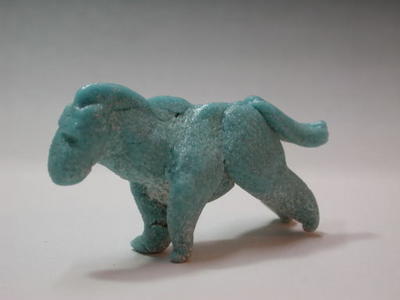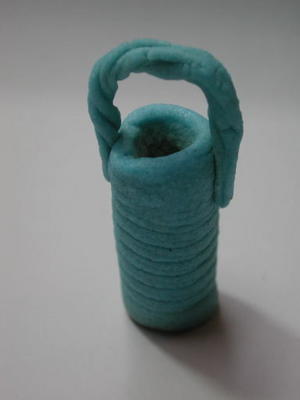The Tried-and-true Recipe
There are dozens of Egyptian paste recipes and where to start is not always apparent. Add to this the fact that you can buy premixed; however manufactures can change formulation without informing you and it’s rather dear. This recipe from an old ceramics monthly (Behrens) was chosen for a number of reasons. First is mixed by measures, so there’s no need for gram scale. Secondly, there is no clay in this formula; it’s mostly quartz, which is close to the composition of the archaeological finds. Third, there are very few ingredients and it’s inexpensive. And lastly, it can be modified easily. For those unfamiliar with studio, hygiene I am mentioning this: it is IMPERATIVE TO WEAR RESPIRATOR when measuring and mixing anything that contains free silica. The recipe is as follows:
16 parts, silica (325 to 400 mesh)
4 parts, bentonite .
2 parts, baking soda
this is the basic mix to this add one half part copper carbonate for turquoise color. I’ve tried a few other recipes but this one is tried-and-true; it is adequate for the time being.

Labels: Egyptian paste recipe, faience clay, paste mix


41 Comments:
But why did you stop the blog, I wanted so much to learn about this. I could not find much information at all. thank you
In the five years this blog has been up it appears you're the only one who's ever read it. As you know, blogs were a lot of work.
Well, sorry to say I found it too late! Are you still working in this technique?
If nothing else thanks for leaving it actively UP for me to find! I have been looking for a recipe and wanted to try it, I have a background in ceramics and currently work in metal clays...so all things paste/ clays are interesting for me...this one appeals for the historical significance and also the exotic factor of course. :-) I also have been loking for several hours already online for "recipes" so I could try it myself....and differnt info on where I could learn this MAYBE in a class....
Well there is news on the Egyptian paste front. As of two months ago, I reactivated this blog. There are six new postings since then and more to come. There are two people who are actually following the blog. I've been reporting on my last kiln experiments with the Egyptian paste. Videos have been posted to the blog! So go to the top of this page and click on --->Egyptian Paste (aka Faience)
e ya later,
--------Anitra
Keep it UP!
You have another reader!
Yeah another reader here too. Doing faience for a project.
Another reader in New Zealand. Thanks for the blog - very informative. Just starting out with Egyptian paste.
It looks like its been years since anyone has written on this blog, but I wanted to thank you for sharing the information. Have you ever considered using this recipe as an engobe?
I am happy to have found this.
I am not a member of the site, and with many who aren't your blog may be reaching more than you think. >_^
It looks very pretty but wondered where you can get the copper carbonate to make it? :)
Go on you do a good work
I'd like to follow this blog but don't know how!
Very interesting. Thanks!
Just found you thanks to Clay Club out of North Carolina... This is a great source, thanks for keeping it up & running.
Thank you so very much! I've been searching for how to make the Egyptian Faience beads, to match a 26th Dynasty Amulet of Sekhmet I've had for years. I wanted to be authentic, so I could match the greenish color.
Do you have a recommended firing temperature and time?
Another person from down under, interesting stuff, it would be intersting seeing the results of other people's research and items made, I have been interested in EP for many years and had a friend bring me some EP beads back from Iran, as she knew I was very interested, they were just beautiful, its getting the recipe and mixture just right, but very intersting results you have had. Cheers for the blog I liked it very much.
Hi, thanks for sharing your tests!
I have tried this formula and found the turquoise color fades a lot after a few months or year or so. Have you had this issue too, and if so, what addition to the mix would you suggest to stabilize it?
Thanks!
does this need to be fired in a kiln or are you able to do it in a normal oven?
I have quite a collection of Faience recipes if anyone wants them... BHClaysmith@gmail.com
Lovely clear and simple recipe ... and it works well. Many Thanks
And yet another...Was watching PBS on Egyptian art and got interested inushabti.
Would love them.
Excellent stuff! ^_^
New reader from Lithuania! ��
Just found your blog. We have just started making Egyptian paste beads. Second firing turned out very well. We are from New Zealand
Ah Found your recipe!
Thank you!
Thank-you for listing your article & recipe on "Egyption Paste-Faience". I had purchased some "Glass Clay" to make and have not got around to doing it. I was trying to look up whether I should fire the metal clay 1st then insert the Glass clay, and came across new info that it is called "Egyption Paste-Faience". Still haven't found my answer, but thoroughly enjoyed your receipe!!!
I’m doing some Egyptian paste research right now, very happy to have found this! I’ve tried a few recipes and narrowed it down to one I like. Now trying different colors and approaches—marbleized seems most effective to me. Always happy to see other enthusiasts!
I’m doing some Egyptian paste research right now, very happy to have found this! I’ve tried a few recipes and narrowed it down to one I like. Now trying different colors and approaches—marbleized seems most effective to me. Always happy to see other enthusiasts!
Found my book on Glass clay. It said to fire the glass clay 1st, then insert it in the metal clay piece to be fired.
Thanks for the recipe, I can't wait to try it. For those who asked, all materials can be found on Amazon.
العملاء الأعزاء ،
هل تحتاج مساعدة مالية؟ هل أنت في أزمة مالية وتجد صعوبة في الحصول على قرض من البنوك المحلية والمؤسسات المالية الأخرى؟ ها هي فرصتك للحصول على قرض. احصل على قروض فورية قصيرة وطويلة الأجل لسداد الديون أو لبدء مشروعك التجاري الخاص والتمتع بفوائد كونك رئيسك الخاص.
تمويل شخصي
تمويل الأعمال التجارية
بمعدل فائدة 2٪
في غضون 1 إلى 10 سنوات
اتصل بنا عبر البريد الإلكتروني: expertinfoq@gmail.com
I too just found this post after searching for some time. I too would like to know more and if this can be used in coe 90 fused glass art?
Thanks for the recipe, but bentonite IS a type of clay.
Does anyone have any ideas on producing a white "frosty glaze faince? perhaps substituting tin instead of copper/cobalt combinations?
Has anyone attempted to substitute perlite for the silica? I ground up the perlite with a coffee grinder. I also ground up cheap kitty litter which is bentonite. What type of liquid is used to make the paste?
Hello. If you are still checking by your messages may I ask what temperature or cone you fired the paste too? And how many days you let it sit? Very beautiful surface. Thank you for sharing this.
Post a Comment
Subscribe to Post Comments [Atom]
<< Home